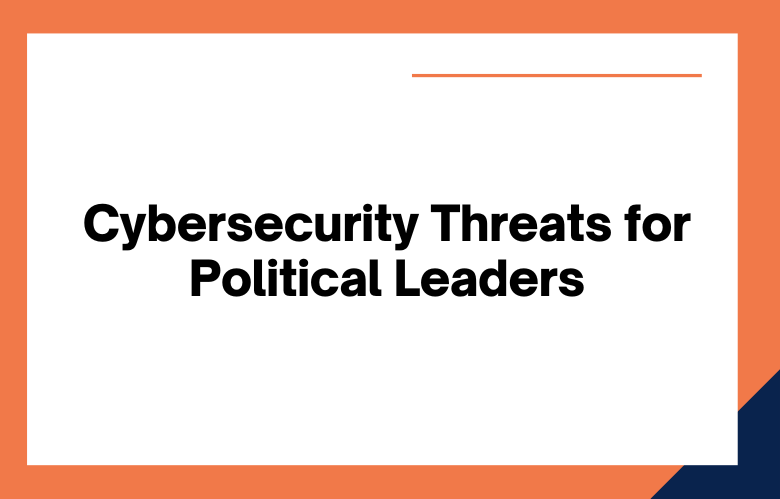As a political leader, you face many threats to your security and privacy. The blog post will outline the top cybersecurity threats you must know and take steps to protect yourself. From cybercriminals looking to steal your information to nation-state actors trying to hack into your networks, the threats pose a serious risk to your safety and security. So ensure you are protected by using strong passwords, installing antivirus software, and keeping your devices up-to-date with the latest security patches. Doing so can help mitigate these risks and keep yourself safe online.
Cybersecurity threats are becoming an increasingly important issue for political leaders worldwide. Cybercriminals have found new ways to exploit our systems and steal data as we increasingly rely on technology. This blog post will examine some top cybersecurity threats facing political leaders today.
As a political leader, you are responsible for the security of your country and its citizens. You rely on your cybersecurity experts to protect your networks from malicious actors, but what are the most significant threats you face? The blog post discusses political leaders’ top cybersecurity threats and tips for mitigating them.
Top Cybersecurity Threats for Political Leaders
Cybersecurity threats are increasing in number and severity, making them a top concern for political leaders. Here are the three most significant cybersecurity threats that political leaders need to be aware of:
The cyber world is becoming increasingly complex, and hackers are becoming more sophisticated. As a result, political leaders are facing new cybersecurity threats. Here are some of the top threats they face:
Phishing attacks occur when hackers send emails that appear to be legitimate sources to trick victims into disclosing personal information on malicious links.
Ransomware attacks happen when hackers have control of a victim’s computer and demand a ransom to release it.
Malware attacks:
Malware is malicious software that damages a computer or steals information. Hackers can use it to access a victim’s computer and cause severe damage.
These are some of the cybersecurity threats that political leaders are facing. With the rapid evolution of technology, they must stay up-to-date on the latest threats and how to protect themselves and their organizations.
Malware is software that damages computers. It includes viruses, Trojans, worms, and ransomware.
Data breaches occur when an attacker gains access to confidential or sensitive information. It happens through various methods, including hacking into systems or stealing physical devices such as laptops or USB drives.
The software damages or disable computers and other devices. It is installed on a machine without the user’s knowledge and causes serious problems, such as data loss or theft.
Denial of service attacks involves hackers flooding a website or server with requests, making it difficult for legitimate users to access. It can slow down work or prevent people from being able to access important information.
Short for “malicious software,” this is any software used to damage or disable computers.
Ransomware:
Ransomware encrypts data on a victim’s computer that demands payment to unlock the data. The attack is becoming increasingly common and can be very costly for organizations.
The type of malware encrypts your files and demands a ransom to decrypt them. It can be incredibly costly for political organizations if sensitive data leaks.
Phishing:
Phishing attacks involve sending emails to unsuspecting victims with links or attachments that contain malware. These attacks can be very effective at obtaining sensitive information from individuals. Emails or messages appear from a trusted source but are from hackers, designed to trick users into revealing sensitive information.
These emails look like they come from a trusted source but are fake. They can trick you into clicking on a link or attachment that installs malware on your device.
This attack involves an attacker pretending to be someone else to access sensitive information. It is by emails, websites, or even social media.
Identity Theft:
Identity theft occurs when anyone steals someone else’s personal information to commit fraud or other crimes. This type of crime can be very costly and challenging to resolve.
DDoS attacks:
A denial of service charge overwhelms belief Russian Federation,” “harassment and cyberstalking of a National Security Agency contractor.” They can crush a website or online service with so much traffic that it becomes inaccessible. Often, these attacks are by botnets, networks of infected computers controlled by hackers.
- Phishing attacks trick you into giving up sensitive information
- Malware that could disable your devices or compromise your data
- DDoS attacks that could take down your website or online campaign
- The ever-present threat of data breaches and leaks
A DOS (denial of service) attack is when a hacker prevents legitimate users from accessing a system or service. It is by flooding the system with traffic or requests, making it unavailable.
Malware is constantly evolving and becoming more sophisticated. Last year, several high-profile ransomware attacks targeted political leaders and their organizations.
Phishing attacks are also rising as cybercriminals become more clever in disguising themselves and their email messages. These attacks can have serious consequences, as sensitive information can be stolen and used maliciously.
The attack makes a website or server unavailable to users. It is typically done by flooding the site with traffic or requests, making it difficult for legitimate users to access.
Phishing attacks are a significant cybersecurity threat for political leaders. These attacks often involve spoofed emails that appear to come from a legitimate source, such as a financial institution or government agency.
The email contains a malicious link or attachment that can infect the recipient’s computer with malware. Once infected, the malware may steal sensitive information, such as login credentials or financial data.
Data breaches are another major threat to political leaders. Data breaches can occur when hackers access an organization’s computer systems and steal confidential information.
This stolen information may include customer records, employee information, or other sensitive data. A data breach has severe consequences for both the organizations and individuals affected by it.
Cybersecurity threats are a significant problem for political leaders. Organizations and individuals must take steps to protect themselves from these threats.
Phishing attacks involve hackers trying to trick people into giving them sensitive information, such as passwords or credit card numbers. They often send fake emails or messages that appear to be from trustworthy sources.
Hacking:
One of the main ways that cybercriminals can access sensitive information is by hacking into systems. Various methods, such as phishing emails or malicious software, do it.
Data breaches:
Another major cybersecurity threat is data breaches. It occurs when someone unauthorized gains access to confidential information. Usually, this is by hackers who exploit weaknesses in systems.
Identity theft:
Identity theft is another usual form of cybercrime. It occurs when someone’s personal information, such as Social Security or credit card number, is stolen and used without permission.
- Phishing campaigns target political party members to gain access to sensitive information.
- Cyberattacks disrupt critical infrastructures, such as power grids or transportation systems.
- It is hacking attempts on government databases that contain sensitive information about citizens.
Social Engineering Attacks
Social engineering attacks are becoming increasingly common. In these attacks, cybercriminals exploit people’s trust in others to access sensitive information or systems. Manipulating people by giving confidential information such as passwords or credit card numbers
- Ransomware- a type of malware that encrypts files on a user’s computer and demands payment to unlock them. Attackers encrypt files on a computer and demand payment for the decryption key.
- Phishing- emails or websites trick users into revealing sensitive information such as passwords or credit card numbers. Emails appear to be a legitimate source but are from scammers, designed to get personal information like passwords or credit card numbers.
- Malvertising- the use of malicious advertising to spread malware
- Social engineering- manipulating people into giving away confidential information such as passwords or credit card numbers
- Doxing- the publishing of personal information, such as home addresses and social media profiles, with the intent to harass or intimidate
- Botnets- networks of compromised computers used to send spam emails, launch denial of service attacks, or mine cryptocurrencies
- Data breaches- the unauthorized access and theft of data from corporate and government databases
- Cyber espionage- the stealing of intellectual property and trade secrets from businesses and governments
- Social media scams- fake social media profiles that use to gather information about people or spread malware
- Data breaches- when hackers gain access to sensitive data like credit card numbers or social security numbers
- Malvertising- ads that contain malware and clicks on by unsuspecting users
- Botnets- networks of computers that have been infected with malware and can control by the attacker
- IoT devices- smart TVs, home assistants, and other internet-connected devices that can be hacked and used to spy on people or launch attacks against other networks
- Mobile security threats- apps that collect personal information, viruses that attack Android phones, etc
- DDoS attacks- using multiple computers to flood a website with traffic, preventing legitimate users from accessing it
- Malvertising- ads containing malware that can infect your computer when you click on them
- Spyware- software that collects information about your activities without your knowledge
- Brute force attacks- trying many different passwords until one works
- Zero-day exploits- vulnerabilities in software have not yet been discovered.
- Malicious software that can steal or damage data
- Phishing attacks trick people into giving away their passwords or other sensitive information.
- Ransomware, which locks people out of their computers until they pay a ransom
- Social engineering tricks people into giving away their passwords or other sensitive information.
- Unsecured Wi-Fi networks
- Outdated software and operating systems
- USB sticks with malicious software on them
- Laptops that are lost or stolen
- Spyware- software that collects data about users without their knowledge or consent
- Viruses and worms- self-replicating pieces of code that can damage computer systems
- BYOD policies- employees bringing their own devices (such as laptops, smartphones, and tablets) to work and connecting them to the company network
- Unsecured networks- networks without firewalls or other security measures in place that can easily hack
- Insufficient cybersecurity staffing and training- many organizations do not have enough staff members who train in cybersecurity.
These are some of the many cybersecurity threats political leaders face today. They must be aware of these threats and protect themselves and their organizations against them.
Conclusion
Cybersecurity threats are constantly evolving and changing. As a result, political leaders need to access the latest information on cybersecurity threats and how to protect themselves and their organizations from them.
Contact us today for Political Leader Security Consulting services. We help you stay ahead of the curve regarding cybersecurity threats and keep your organization safe.











